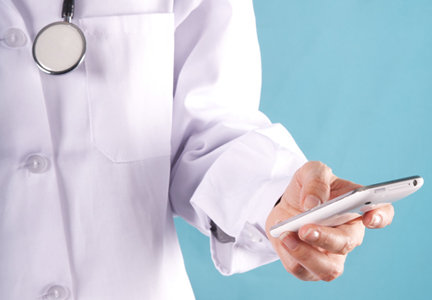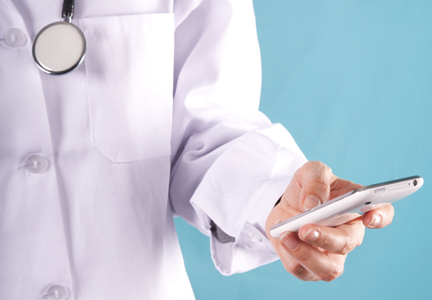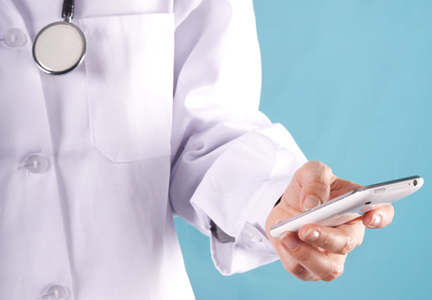User login
Natural Standard
What is it?
Natural Standard is a highly esteemed online resource that provides authoritative, high-quality, evidence-based information about complementary and alternative medicine. This app provides monographs for the 400 most commonly used herbs and supplements from the Natural Standard database. Grades are provided for or against the use of each therapy for specific medical conditions.
How does it work?
The app opens in the search screen with a search field at the top of the screen. Below the search box are 4 buttons that allow you to perform the following searches: a Quick Search of words exactly as typed, a Fuzzy Filter that matches words by nearest spelling, a Keyword search of individual words within a compound’s name, and a Wild Card search that finds nearest matches by replacing individual letters or groups of letters.
Selecting a supplement opens its monograph. Each monograph includes a list of related terms for the supplement, a background section providing a general overview of the supplement, an evidence section providing detailed explanations of clinical trial data by indication, a dosing section, a safety section, and an interactions section. The evidence section provides a rating grade from A (strong positive scientific evidence) through F (strong negative scientific evidence).
How can it help me?
Patients come to my clinic every day with questions about herbs and supplements. I use the Natural Standard online resource whenever I want high-quality, evidence-based information on herbs and supplements. The app is not as extensive as the Web-based resource but provides more than enough information for discussing risks and benefits of herbs and supplements with patients bedside. Because Natural Standard is maintained by health care providers and researchers and is not supported by any interest group, professional organization, or product manufacturer, patients and providers can have high confidence in information provided by this app.
How can I get it?
Natural Standard can be downloaded from the Apple App Store for iPhone and iPad for $59.99; the Google Play Store for $59.99; or Skyscape for smartphones, personal computers, and other devices for $79.95.
If you would like to recommend an app, e-mail our Editorial Office.
What is it?
Natural Standard is a highly esteemed online resource that provides authoritative, high-quality, evidence-based information about complementary and alternative medicine. This app provides monographs for the 400 most commonly used herbs and supplements from the Natural Standard database. Grades are provided for or against the use of each therapy for specific medical conditions.
How does it work?
The app opens in the search screen with a search field at the top of the screen. Below the search box are 4 buttons that allow you to perform the following searches: a Quick Search of words exactly as typed, a Fuzzy Filter that matches words by nearest spelling, a Keyword search of individual words within a compound’s name, and a Wild Card search that finds nearest matches by replacing individual letters or groups of letters.
Selecting a supplement opens its monograph. Each monograph includes a list of related terms for the supplement, a background section providing a general overview of the supplement, an evidence section providing detailed explanations of clinical trial data by indication, a dosing section, a safety section, and an interactions section. The evidence section provides a rating grade from A (strong positive scientific evidence) through F (strong negative scientific evidence).
How can it help me?
Patients come to my clinic every day with questions about herbs and supplements. I use the Natural Standard online resource whenever I want high-quality, evidence-based information on herbs and supplements. The app is not as extensive as the Web-based resource but provides more than enough information for discussing risks and benefits of herbs and supplements with patients bedside. Because Natural Standard is maintained by health care providers and researchers and is not supported by any interest group, professional organization, or product manufacturer, patients and providers can have high confidence in information provided by this app.
How can I get it?
Natural Standard can be downloaded from the Apple App Store for iPhone and iPad for $59.99; the Google Play Store for $59.99; or Skyscape for smartphones, personal computers, and other devices for $79.95.
If you would like to recommend an app, e-mail our Editorial Office.
What is it?
Natural Standard is a highly esteemed online resource that provides authoritative, high-quality, evidence-based information about complementary and alternative medicine. This app provides monographs for the 400 most commonly used herbs and supplements from the Natural Standard database. Grades are provided for or against the use of each therapy for specific medical conditions.
How does it work?
The app opens in the search screen with a search field at the top of the screen. Below the search box are 4 buttons that allow you to perform the following searches: a Quick Search of words exactly as typed, a Fuzzy Filter that matches words by nearest spelling, a Keyword search of individual words within a compound’s name, and a Wild Card search that finds nearest matches by replacing individual letters or groups of letters.
Selecting a supplement opens its monograph. Each monograph includes a list of related terms for the supplement, a background section providing a general overview of the supplement, an evidence section providing detailed explanations of clinical trial data by indication, a dosing section, a safety section, and an interactions section. The evidence section provides a rating grade from A (strong positive scientific evidence) through F (strong negative scientific evidence).
How can it help me?
Patients come to my clinic every day with questions about herbs and supplements. I use the Natural Standard online resource whenever I want high-quality, evidence-based information on herbs and supplements. The app is not as extensive as the Web-based resource but provides more than enough information for discussing risks and benefits of herbs and supplements with patients bedside. Because Natural Standard is maintained by health care providers and researchers and is not supported by any interest group, professional organization, or product manufacturer, patients and providers can have high confidence in information provided by this app.
How can I get it?
Natural Standard can be downloaded from the Apple App Store for iPhone and iPad for $59.99; the Google Play Store for $59.99; or Skyscape for smartphones, personal computers, and other devices for $79.95.
If you would like to recommend an app, e-mail our Editorial Office.
Fantastical 2
What is it?
This app is an alternative to iCal for iPhones and iPads that maintains an intuitive user interface while adding features not available in iCal. As a busy dermatologist, it is my favorite app for keeping my schedule straight.
How does it work?
Fantastical 2 opens in the DayTicker view with a block view of the days of the week on the top of the screen and the events for the week listed underneath. Integrated with calendar events are tasks from the reminders app in iOS devices. Pulling down on the DayTicker converts the view to a month calendar. Rotating your iPhone to landscape converts the view to a week calendar.
The best feature of the app is its natural language parser. Tapping on the plus sign that appears in the upper right corner of the screen prompts the user to enter an event using natural language. As the event is typed, Fantastical simultaneously shows the event being placed into your calendar. Before you press Return, you know the event will go into the calendar exactly as you expect it. Recurring events such as “Clinic in Timbuktu second Friday every month” also can be created the same way. Starting sentences with “remind me to,” “reminder,” “to do,” or “task” will create a task in the iOS reminders app.
How can it help me?
Fantastical 2 is my favorite app for entering appointments on the go. I love the ability to enter text using natural language into one text box and see events scheduled in the correct place in my calendar as I type.
How can I get it?
Fantastical 2 is available from the Apple App Store for your iPhone and iPad. The cost to buy the app for the iPhone is $4.99 and $9.99 for the iPad.
If you would like to recommend an app, e-mail our Editorial Office.
What is it?
This app is an alternative to iCal for iPhones and iPads that maintains an intuitive user interface while adding features not available in iCal. As a busy dermatologist, it is my favorite app for keeping my schedule straight.
How does it work?
Fantastical 2 opens in the DayTicker view with a block view of the days of the week on the top of the screen and the events for the week listed underneath. Integrated with calendar events are tasks from the reminders app in iOS devices. Pulling down on the DayTicker converts the view to a month calendar. Rotating your iPhone to landscape converts the view to a week calendar.
The best feature of the app is its natural language parser. Tapping on the plus sign that appears in the upper right corner of the screen prompts the user to enter an event using natural language. As the event is typed, Fantastical simultaneously shows the event being placed into your calendar. Before you press Return, you know the event will go into the calendar exactly as you expect it. Recurring events such as “Clinic in Timbuktu second Friday every month” also can be created the same way. Starting sentences with “remind me to,” “reminder,” “to do,” or “task” will create a task in the iOS reminders app.
How can it help me?
Fantastical 2 is my favorite app for entering appointments on the go. I love the ability to enter text using natural language into one text box and see events scheduled in the correct place in my calendar as I type.
How can I get it?
Fantastical 2 is available from the Apple App Store for your iPhone and iPad. The cost to buy the app for the iPhone is $4.99 and $9.99 for the iPad.
If you would like to recommend an app, e-mail our Editorial Office.
What is it?
This app is an alternative to iCal for iPhones and iPads that maintains an intuitive user interface while adding features not available in iCal. As a busy dermatologist, it is my favorite app for keeping my schedule straight.
How does it work?
Fantastical 2 opens in the DayTicker view with a block view of the days of the week on the top of the screen and the events for the week listed underneath. Integrated with calendar events are tasks from the reminders app in iOS devices. Pulling down on the DayTicker converts the view to a month calendar. Rotating your iPhone to landscape converts the view to a week calendar.
The best feature of the app is its natural language parser. Tapping on the plus sign that appears in the upper right corner of the screen prompts the user to enter an event using natural language. As the event is typed, Fantastical simultaneously shows the event being placed into your calendar. Before you press Return, you know the event will go into the calendar exactly as you expect it. Recurring events such as “Clinic in Timbuktu second Friday every month” also can be created the same way. Starting sentences with “remind me to,” “reminder,” “to do,” or “task” will create a task in the iOS reminders app.
How can it help me?
Fantastical 2 is my favorite app for entering appointments on the go. I love the ability to enter text using natural language into one text box and see events scheduled in the correct place in my calendar as I type.
How can I get it?
Fantastical 2 is available from the Apple App Store for your iPhone and iPad. The cost to buy the app for the iPhone is $4.99 and $9.99 for the iPad.
If you would like to recommend an app, e-mail our Editorial Office.
Medscape Mobile
What is it?
This app contains a collection of medical reference materials, specialty-specific news stories, and continuing medical education (CME) courses.
How does it work?
Prior to using this app, the user must register with Medscape, providing your name, country, e-mail address, zip code, and specialty. Your name, specialty, and country of practice are shared with third-party sponsors; however, your e-mail address and other personally identifiable information are not shared.
Once in the app, Medscape Mobile provides an intuitive interface that allows you to view reference materials, CME, or news. Reference materials include a drug reference tool that includes prescribing and safety information for prescription, over-the-counter, and herbal medications; a drug interaction checker; a medical calculator with 129 different formulas, scales, and classifications; formulary information for approximately 2000 insurance plans; a disease and condition reference with up-to-date information on more than 4000 diseases; and a procedure reference with instructions on more than 1000 medical procedures. All of the reference materials can be downloaded in one step, allowing you to subsequently access all of the reference materials without Internet access.
In addition, the app includes daily specialty-specific medical news articles and accredited CME courses. Education courses often are provided as videos and screenshots paired with transcriptions for users who prefer reading versus listening to presentations. News articles are timely and cover US Food and Drug Administration announcements, thought leader perspectives, notable journal articles, and the business of medicine.
How can it help me?
Medscape Mobile is made for providers who prefer lots of different types of information within one app. It is the “Swiss Army Knife” of mobile medical apps providing a broad range of reference materials, medical calculators, news, and CME.
I have all the reference materials downloaded on my smartphone, as that allows me fast access to all the drug and clinical reference information during hospital rounds when I may have none or limited wireless Internet access. Although the larger screen of a tablet may be useful for the education and news sections, I personally prefer other sources for my dermatology medical news and CME. Therefore, I only use the smartphone interface.
The disease information also is limited for less common or subspecialty-specific dermatologic diseases. For example, there is no information on Conradi-Hünermann-Happle syndrome, neonatal cephalic pustulosis, or neonatal acne, diseases of interest to a pediatric dermatologist. I, therefore, do not use the dermatology disease and dermatology procedure references in my workflow. I do use the disease and procedure reference materials to familiarize myself with basic disease and procedure information outside of dermatology.
How can I get it?
Because Medscape Mobile is free, every dermatologist should try it. It is available from the Apple App Store for your iPhone and iPad and from the Google Play Store.
If you would like to recommend an app, e-mail our Editorial Office.
What is it?
This app contains a collection of medical reference materials, specialty-specific news stories, and continuing medical education (CME) courses.
How does it work?
Prior to using this app, the user must register with Medscape, providing your name, country, e-mail address, zip code, and specialty. Your name, specialty, and country of practice are shared with third-party sponsors; however, your e-mail address and other personally identifiable information are not shared.
Once in the app, Medscape Mobile provides an intuitive interface that allows you to view reference materials, CME, or news. Reference materials include a drug reference tool that includes prescribing and safety information for prescription, over-the-counter, and herbal medications; a drug interaction checker; a medical calculator with 129 different formulas, scales, and classifications; formulary information for approximately 2000 insurance plans; a disease and condition reference with up-to-date information on more than 4000 diseases; and a procedure reference with instructions on more than 1000 medical procedures. All of the reference materials can be downloaded in one step, allowing you to subsequently access all of the reference materials without Internet access.
In addition, the app includes daily specialty-specific medical news articles and accredited CME courses. Education courses often are provided as videos and screenshots paired with transcriptions for users who prefer reading versus listening to presentations. News articles are timely and cover US Food and Drug Administration announcements, thought leader perspectives, notable journal articles, and the business of medicine.
How can it help me?
Medscape Mobile is made for providers who prefer lots of different types of information within one app. It is the “Swiss Army Knife” of mobile medical apps providing a broad range of reference materials, medical calculators, news, and CME.
I have all the reference materials downloaded on my smartphone, as that allows me fast access to all the drug and clinical reference information during hospital rounds when I may have none or limited wireless Internet access. Although the larger screen of a tablet may be useful for the education and news sections, I personally prefer other sources for my dermatology medical news and CME. Therefore, I only use the smartphone interface.
The disease information also is limited for less common or subspecialty-specific dermatologic diseases. For example, there is no information on Conradi-Hünermann-Happle syndrome, neonatal cephalic pustulosis, or neonatal acne, diseases of interest to a pediatric dermatologist. I, therefore, do not use the dermatology disease and dermatology procedure references in my workflow. I do use the disease and procedure reference materials to familiarize myself with basic disease and procedure information outside of dermatology.
How can I get it?
Because Medscape Mobile is free, every dermatologist should try it. It is available from the Apple App Store for your iPhone and iPad and from the Google Play Store.
If you would like to recommend an app, e-mail our Editorial Office.
What is it?
This app contains a collection of medical reference materials, specialty-specific news stories, and continuing medical education (CME) courses.
How does it work?
Prior to using this app, the user must register with Medscape, providing your name, country, e-mail address, zip code, and specialty. Your name, specialty, and country of practice are shared with third-party sponsors; however, your e-mail address and other personally identifiable information are not shared.
Once in the app, Medscape Mobile provides an intuitive interface that allows you to view reference materials, CME, or news. Reference materials include a drug reference tool that includes prescribing and safety information for prescription, over-the-counter, and herbal medications; a drug interaction checker; a medical calculator with 129 different formulas, scales, and classifications; formulary information for approximately 2000 insurance plans; a disease and condition reference with up-to-date information on more than 4000 diseases; and a procedure reference with instructions on more than 1000 medical procedures. All of the reference materials can be downloaded in one step, allowing you to subsequently access all of the reference materials without Internet access.
In addition, the app includes daily specialty-specific medical news articles and accredited CME courses. Education courses often are provided as videos and screenshots paired with transcriptions for users who prefer reading versus listening to presentations. News articles are timely and cover US Food and Drug Administration announcements, thought leader perspectives, notable journal articles, and the business of medicine.
How can it help me?
Medscape Mobile is made for providers who prefer lots of different types of information within one app. It is the “Swiss Army Knife” of mobile medical apps providing a broad range of reference materials, medical calculators, news, and CME.
I have all the reference materials downloaded on my smartphone, as that allows me fast access to all the drug and clinical reference information during hospital rounds when I may have none or limited wireless Internet access. Although the larger screen of a tablet may be useful for the education and news sections, I personally prefer other sources for my dermatology medical news and CME. Therefore, I only use the smartphone interface.
The disease information also is limited for less common or subspecialty-specific dermatologic diseases. For example, there is no information on Conradi-Hünermann-Happle syndrome, neonatal cephalic pustulosis, or neonatal acne, diseases of interest to a pediatric dermatologist. I, therefore, do not use the dermatology disease and dermatology procedure references in my workflow. I do use the disease and procedure reference materials to familiarize myself with basic disease and procedure information outside of dermatology.
How can I get it?
Because Medscape Mobile is free, every dermatologist should try it. It is available from the Apple App Store for your iPhone and iPad and from the Google Play Store.
If you would like to recommend an app, e-mail our Editorial Office.
myDermPath
What is it?
myDermPath is an interactive app designed as a learning and practice tool for dermatopathology. It contains a huge image library, diagnostic algorithms, glossaries, and more than 2000 image-based quiz questions.
How does it work?
The initial interface consists of 9 tabs, each directing the user down a different learning pathway. The tabs include About myDermPath, myDermPath Algorithm, Search By Diagnosis, Special Stains, Immunohistochemistry, Direct Immunofluorescence, Glossary Of Terms, Normal Skin Histology, and Ready For A Pop Quiz.
Histopathologic disease descriptions can be obtained through the interactive myDermPath Algorithm in which the user is walked through a short series of descriptive questions until a diagnosis is reached. Alternatively, the user can search by diagnosis. The final diagnosis page gives a brief description of histology, clinical characteristics, management, and differential diagnosis. A representative histologic image, an annotated image, and digital slide are provided. Finally, there are options to add your own notes, incorporate your own slides, or search the diagnosis on PubMed.
Short algorithms also are used to suggest special stains, immunohistochemistry, and direct immunofluorescence. Each stain or marker is paired with a representative slide. Searching directly for specific special stains, immunostains, or immunomarkers, however, is not possible.
Lastly, a section called Ready For A Pop Quiz randomly selects images from a database of more than 2000 slides and asks users to choose the best diagnosis for the presented slide from multiple choices. Each slide can be expanded to a very good detail, full-screen view.
How can it help me?
This app is a favorite of dermatology residents at my institution. Because it was written by 3 experts in dermatopathology, the information is reliable. The algorithms are quick to complete and the information provided is concise, allowing this app to be used by residents for a quick review during dermatopathology teaching sessions. The quiz bank with more 2000 high-quality slides is very convenient for short self-testing sessions. myDermPath is an excellent supplement to any dermatopathology learning program for the general dermatologist.
How can I get it?
myDermPath is free, so every dermatology learner should download this app and give it a try. It is available from the Apple App Store for your iPhone and iPad and from the Google Play Store.
If you would like to recommend an app, e-mail our Editorial Office.
What is it?
myDermPath is an interactive app designed as a learning and practice tool for dermatopathology. It contains a huge image library, diagnostic algorithms, glossaries, and more than 2000 image-based quiz questions.
How does it work?
The initial interface consists of 9 tabs, each directing the user down a different learning pathway. The tabs include About myDermPath, myDermPath Algorithm, Search By Diagnosis, Special Stains, Immunohistochemistry, Direct Immunofluorescence, Glossary Of Terms, Normal Skin Histology, and Ready For A Pop Quiz.
Histopathologic disease descriptions can be obtained through the interactive myDermPath Algorithm in which the user is walked through a short series of descriptive questions until a diagnosis is reached. Alternatively, the user can search by diagnosis. The final diagnosis page gives a brief description of histology, clinical characteristics, management, and differential diagnosis. A representative histologic image, an annotated image, and digital slide are provided. Finally, there are options to add your own notes, incorporate your own slides, or search the diagnosis on PubMed.
Short algorithms also are used to suggest special stains, immunohistochemistry, and direct immunofluorescence. Each stain or marker is paired with a representative slide. Searching directly for specific special stains, immunostains, or immunomarkers, however, is not possible.
Lastly, a section called Ready For A Pop Quiz randomly selects images from a database of more than 2000 slides and asks users to choose the best diagnosis for the presented slide from multiple choices. Each slide can be expanded to a very good detail, full-screen view.
How can it help me?
This app is a favorite of dermatology residents at my institution. Because it was written by 3 experts in dermatopathology, the information is reliable. The algorithms are quick to complete and the information provided is concise, allowing this app to be used by residents for a quick review during dermatopathology teaching sessions. The quiz bank with more 2000 high-quality slides is very convenient for short self-testing sessions. myDermPath is an excellent supplement to any dermatopathology learning program for the general dermatologist.
How can I get it?
myDermPath is free, so every dermatology learner should download this app and give it a try. It is available from the Apple App Store for your iPhone and iPad and from the Google Play Store.
If you would like to recommend an app, e-mail our Editorial Office.
What is it?
myDermPath is an interactive app designed as a learning and practice tool for dermatopathology. It contains a huge image library, diagnostic algorithms, glossaries, and more than 2000 image-based quiz questions.
How does it work?
The initial interface consists of 9 tabs, each directing the user down a different learning pathway. The tabs include About myDermPath, myDermPath Algorithm, Search By Diagnosis, Special Stains, Immunohistochemistry, Direct Immunofluorescence, Glossary Of Terms, Normal Skin Histology, and Ready For A Pop Quiz.
Histopathologic disease descriptions can be obtained through the interactive myDermPath Algorithm in which the user is walked through a short series of descriptive questions until a diagnosis is reached. Alternatively, the user can search by diagnosis. The final diagnosis page gives a brief description of histology, clinical characteristics, management, and differential diagnosis. A representative histologic image, an annotated image, and digital slide are provided. Finally, there are options to add your own notes, incorporate your own slides, or search the diagnosis on PubMed.
Short algorithms also are used to suggest special stains, immunohistochemistry, and direct immunofluorescence. Each stain or marker is paired with a representative slide. Searching directly for specific special stains, immunostains, or immunomarkers, however, is not possible.
Lastly, a section called Ready For A Pop Quiz randomly selects images from a database of more than 2000 slides and asks users to choose the best diagnosis for the presented slide from multiple choices. Each slide can be expanded to a very good detail, full-screen view.
How can it help me?
This app is a favorite of dermatology residents at my institution. Because it was written by 3 experts in dermatopathology, the information is reliable. The algorithms are quick to complete and the information provided is concise, allowing this app to be used by residents for a quick review during dermatopathology teaching sessions. The quiz bank with more 2000 high-quality slides is very convenient for short self-testing sessions. myDermPath is an excellent supplement to any dermatopathology learning program for the general dermatologist.
How can I get it?
myDermPath is free, so every dermatology learner should download this app and give it a try. It is available from the Apple App Store for your iPhone and iPad and from the Google Play Store.
If you would like to recommend an app, e-mail our Editorial Office.
OmniFocus
What is it?
This app is made for people who manage multiple projects in their work and personal life at the same time. It walks users through the process of collecting ideas, processing them into manageable tasks, reviewing priorities, and completing tasks. It is the best app on the market for organizing your life and helping you get things done.
How does it work?
The first time you use OmniFocus, you perform what is called a “mind sweep” and enter everything that is on your mind that may require an eventual action into the Inbox. You enter everything including tasks, ideas, Web sites, daydreams, e-mails, and telephone calls into the Inbox. To make it easy, a variety of tools are provided for entry into the Inbox including an Inbox screen, a New Inbox Item button, a Clippings shortcut, and an e-mail shortcut. OmniFocus also pulls data from Siri and the iPhone calendar app to collect all your tasks into 1 app.
Once all the tasks and ideas that are cluttering up your brain are entered, OmniFocus provides a variety of tools to help you process and organize your life. Tasks can be checked off, grouped into projects, placed On Hold as a delegated task, marked as Waiting if it depends on another action, or placed in a Someday Maybe file. Organization is also aided by Ticklers including start dates, due dates, contexts (eg, home, office) and flags. Finally, folders can be created to organize projects into life roles (eg, work, home, personal) or areas of focus (ie, publishing, medical societies).
When it is time to start working, OmniFocus provides you with a variety of views to easily see what needs to be done. Context view allows you to view tasks based on the tool, person, or place needed to complete the task. Project view allows you to view tasks based on the projects you are currently undertaking. You also can view tasks based on those that are due today or those that you flagged as important. Finally, you can easily create views such as a “today view” that only displays tasks you can complete today.
How can it help me?
This app has been a lifesaver for me. Between my work life, home life, and community life, I am constantly juggling several projects at once. This app allows me to have a busy life and never miss an important deadline because something slipped through the cracks. However, OmniFocus does have a steep learning curve, so I would only use this app if you need to balance many projects in your life; many people can get by with a paper to-do list or an e-mail list.
Learn more about the Getting Things Done system and OmniFocus by reading “OmniFocus, GTD, and You”.
How can I get it?
OmniFocus can be downloaded for free from the Apple App Store for your iPhone and/or iPad and the product Web site. OmniFocus is not available for Android devices at this time.
If you would like to recommend an app, e-mail our Editorial Office.
What is it?
This app is made for people who manage multiple projects in their work and personal life at the same time. It walks users through the process of collecting ideas, processing them into manageable tasks, reviewing priorities, and completing tasks. It is the best app on the market for organizing your life and helping you get things done.
How does it work?
The first time you use OmniFocus, you perform what is called a “mind sweep” and enter everything that is on your mind that may require an eventual action into the Inbox. You enter everything including tasks, ideas, Web sites, daydreams, e-mails, and telephone calls into the Inbox. To make it easy, a variety of tools are provided for entry into the Inbox including an Inbox screen, a New Inbox Item button, a Clippings shortcut, and an e-mail shortcut. OmniFocus also pulls data from Siri and the iPhone calendar app to collect all your tasks into 1 app.
Once all the tasks and ideas that are cluttering up your brain are entered, OmniFocus provides a variety of tools to help you process and organize your life. Tasks can be checked off, grouped into projects, placed On Hold as a delegated task, marked as Waiting if it depends on another action, or placed in a Someday Maybe file. Organization is also aided by Ticklers including start dates, due dates, contexts (eg, home, office) and flags. Finally, folders can be created to organize projects into life roles (eg, work, home, personal) or areas of focus (ie, publishing, medical societies).
When it is time to start working, OmniFocus provides you with a variety of views to easily see what needs to be done. Context view allows you to view tasks based on the tool, person, or place needed to complete the task. Project view allows you to view tasks based on the projects you are currently undertaking. You also can view tasks based on those that are due today or those that you flagged as important. Finally, you can easily create views such as a “today view” that only displays tasks you can complete today.
How can it help me?
This app has been a lifesaver for me. Between my work life, home life, and community life, I am constantly juggling several projects at once. This app allows me to have a busy life and never miss an important deadline because something slipped through the cracks. However, OmniFocus does have a steep learning curve, so I would only use this app if you need to balance many projects in your life; many people can get by with a paper to-do list or an e-mail list.
Learn more about the Getting Things Done system and OmniFocus by reading “OmniFocus, GTD, and You”.
How can I get it?
OmniFocus can be downloaded for free from the Apple App Store for your iPhone and/or iPad and the product Web site. OmniFocus is not available for Android devices at this time.
If you would like to recommend an app, e-mail our Editorial Office.
What is it?
This app is made for people who manage multiple projects in their work and personal life at the same time. It walks users through the process of collecting ideas, processing them into manageable tasks, reviewing priorities, and completing tasks. It is the best app on the market for organizing your life and helping you get things done.
How does it work?
The first time you use OmniFocus, you perform what is called a “mind sweep” and enter everything that is on your mind that may require an eventual action into the Inbox. You enter everything including tasks, ideas, Web sites, daydreams, e-mails, and telephone calls into the Inbox. To make it easy, a variety of tools are provided for entry into the Inbox including an Inbox screen, a New Inbox Item button, a Clippings shortcut, and an e-mail shortcut. OmniFocus also pulls data from Siri and the iPhone calendar app to collect all your tasks into 1 app.
Once all the tasks and ideas that are cluttering up your brain are entered, OmniFocus provides a variety of tools to help you process and organize your life. Tasks can be checked off, grouped into projects, placed On Hold as a delegated task, marked as Waiting if it depends on another action, or placed in a Someday Maybe file. Organization is also aided by Ticklers including start dates, due dates, contexts (eg, home, office) and flags. Finally, folders can be created to organize projects into life roles (eg, work, home, personal) or areas of focus (ie, publishing, medical societies).
When it is time to start working, OmniFocus provides you with a variety of views to easily see what needs to be done. Context view allows you to view tasks based on the tool, person, or place needed to complete the task. Project view allows you to view tasks based on the projects you are currently undertaking. You also can view tasks based on those that are due today or those that you flagged as important. Finally, you can easily create views such as a “today view” that only displays tasks you can complete today.
How can it help me?
This app has been a lifesaver for me. Between my work life, home life, and community life, I am constantly juggling several projects at once. This app allows me to have a busy life and never miss an important deadline because something slipped through the cracks. However, OmniFocus does have a steep learning curve, so I would only use this app if you need to balance many projects in your life; many people can get by with a paper to-do list or an e-mail list.
Learn more about the Getting Things Done system and OmniFocus by reading “OmniFocus, GTD, and You”.
How can I get it?
OmniFocus can be downloaded for free from the Apple App Store for your iPhone and/or iPad and the product Web site. OmniFocus is not available for Android devices at this time.
If you would like to recommend an app, e-mail our Editorial Office.
PubMed for Handhelds (PubMed4Hh)
What is it?
PubMed for Handhelds (PubMed4Hh) is an app created by the National Library of Medicine to facilitate evidence-based medical practice at the point of care using mobile devices. It allows physicians to access journal abstracts and “The Bottom Line” (TBL) summaries, and to select full-text articles.
How does it work?
On opening the app, the user is presented with a directory of 6 mobile-friendly interfaces for searching PubMed: PICO, Consensus Abstracts, askMEDLINE, BabelMeSH, CQs (Clinical Queries), and Archive.
PICO guides the user through the process of creating a well-formulated clinical query based on entering a patient/problem (medical condition), intervention (therapy, diagnostic test), comparison, outcome, and publication type (clinical trial, meta-analysis, randomized controlled trial, systematic reviews, practice guideline).
Consensus Abstracts displays search results with multiple selected abstracts or TBL’s on the same page. Searches are initiated using the PICO or askMEDLINE format.
askMEDLINE allows the provider to search using natural language, such as “What are therapeutic options for melanoma?” Results can be narrowed by publication type.
BabelMeSH allows MEDLINE searches in 12 languages in addition to English: Arabic, Chinese, Dutch, French, German, Italian, Japanese, Korean, Portuguese, Russian, Spanish, and Swedish. It also allows searches using PubMed syntax. For example, “Melanoma[majr]” will restrict citations to those in which melanoma is the major topic or focus of the article and “Melanoma 2002:2004[dp]” will restrict citations to those published between 2002 and 2004.
CQs (Clinical Queries) provides a user interface to add filters for limiting PubMed searches to systematic reviews or a specific emphasis (therapy, diagnosis, etiology, prognosis, clinical prediction guides). Users also can indicate if they prefer a specific (narrow) or sensitive (broad) search. PubMed syntax can be used in this interface.
Archive stores saved search results.
How can it help me?
Because the National Library of Medicine created it, PubMed4Hh is the most reputable and authoritative PubMed search tool for mobile devices. It is excellent for providing access to MEDLINE’s extensive library of journal abstracts and TBL summaries. That being said, the current user interface is confusing and it takes time to become familiar with it. I also do not enjoy being required to learn new syntax to optimize search results. Finally, most of the resources have bugs related to screen space and will not fully display on smartphones, requiring the larger screen of a tablet.
I recommend familiarizing yourself with the application by playing with it in clinic for a couple days, and one of the resources will become your favorite platform for point-of-care retrieval of evidence-based data. I mainly use the Consensus Abstracts resource to view multiple TBLs on the same page. I also have used the syntax “[majr]” to focus searches to my topic and “[dp]” to limit searches to specific dates of publication. Although I do not suggest learning a complete syntax, providers who are interested in expanding their PubMed syntax skills can find a complete tutorial at http://www.ncbi.nlm.nih.gov/books/nbk3827.
How can I get it?
PubMed4Hh can be downloaded for free from the Apple App Store, the Google Play Store, and the product Web site.
What is it?
PubMed for Handhelds (PubMed4Hh) is an app created by the National Library of Medicine to facilitate evidence-based medical practice at the point of care using mobile devices. It allows physicians to access journal abstracts and “The Bottom Line” (TBL) summaries, and to select full-text articles.
How does it work?
On opening the app, the user is presented with a directory of 6 mobile-friendly interfaces for searching PubMed: PICO, Consensus Abstracts, askMEDLINE, BabelMeSH, CQs (Clinical Queries), and Archive.
PICO guides the user through the process of creating a well-formulated clinical query based on entering a patient/problem (medical condition), intervention (therapy, diagnostic test), comparison, outcome, and publication type (clinical trial, meta-analysis, randomized controlled trial, systematic reviews, practice guideline).
Consensus Abstracts displays search results with multiple selected abstracts or TBL’s on the same page. Searches are initiated using the PICO or askMEDLINE format.
askMEDLINE allows the provider to search using natural language, such as “What are therapeutic options for melanoma?” Results can be narrowed by publication type.
BabelMeSH allows MEDLINE searches in 12 languages in addition to English: Arabic, Chinese, Dutch, French, German, Italian, Japanese, Korean, Portuguese, Russian, Spanish, and Swedish. It also allows searches using PubMed syntax. For example, “Melanoma[majr]” will restrict citations to those in which melanoma is the major topic or focus of the article and “Melanoma 2002:2004[dp]” will restrict citations to those published between 2002 and 2004.
CQs (Clinical Queries) provides a user interface to add filters for limiting PubMed searches to systematic reviews or a specific emphasis (therapy, diagnosis, etiology, prognosis, clinical prediction guides). Users also can indicate if they prefer a specific (narrow) or sensitive (broad) search. PubMed syntax can be used in this interface.
Archive stores saved search results.
How can it help me?
Because the National Library of Medicine created it, PubMed4Hh is the most reputable and authoritative PubMed search tool for mobile devices. It is excellent for providing access to MEDLINE’s extensive library of journal abstracts and TBL summaries. That being said, the current user interface is confusing and it takes time to become familiar with it. I also do not enjoy being required to learn new syntax to optimize search results. Finally, most of the resources have bugs related to screen space and will not fully display on smartphones, requiring the larger screen of a tablet.
I recommend familiarizing yourself with the application by playing with it in clinic for a couple days, and one of the resources will become your favorite platform for point-of-care retrieval of evidence-based data. I mainly use the Consensus Abstracts resource to view multiple TBLs on the same page. I also have used the syntax “[majr]” to focus searches to my topic and “[dp]” to limit searches to specific dates of publication. Although I do not suggest learning a complete syntax, providers who are interested in expanding their PubMed syntax skills can find a complete tutorial at http://www.ncbi.nlm.nih.gov/books/nbk3827.
How can I get it?
PubMed4Hh can be downloaded for free from the Apple App Store, the Google Play Store, and the product Web site.
What is it?
PubMed for Handhelds (PubMed4Hh) is an app created by the National Library of Medicine to facilitate evidence-based medical practice at the point of care using mobile devices. It allows physicians to access journal abstracts and “The Bottom Line” (TBL) summaries, and to select full-text articles.
How does it work?
On opening the app, the user is presented with a directory of 6 mobile-friendly interfaces for searching PubMed: PICO, Consensus Abstracts, askMEDLINE, BabelMeSH, CQs (Clinical Queries), and Archive.
PICO guides the user through the process of creating a well-formulated clinical query based on entering a patient/problem (medical condition), intervention (therapy, diagnostic test), comparison, outcome, and publication type (clinical trial, meta-analysis, randomized controlled trial, systematic reviews, practice guideline).
Consensus Abstracts displays search results with multiple selected abstracts or TBL’s on the same page. Searches are initiated using the PICO or askMEDLINE format.
askMEDLINE allows the provider to search using natural language, such as “What are therapeutic options for melanoma?” Results can be narrowed by publication type.
BabelMeSH allows MEDLINE searches in 12 languages in addition to English: Arabic, Chinese, Dutch, French, German, Italian, Japanese, Korean, Portuguese, Russian, Spanish, and Swedish. It also allows searches using PubMed syntax. For example, “Melanoma[majr]” will restrict citations to those in which melanoma is the major topic or focus of the article and “Melanoma 2002:2004[dp]” will restrict citations to those published between 2002 and 2004.
CQs (Clinical Queries) provides a user interface to add filters for limiting PubMed searches to systematic reviews or a specific emphasis (therapy, diagnosis, etiology, prognosis, clinical prediction guides). Users also can indicate if they prefer a specific (narrow) or sensitive (broad) search. PubMed syntax can be used in this interface.
Archive stores saved search results.
How can it help me?
Because the National Library of Medicine created it, PubMed4Hh is the most reputable and authoritative PubMed search tool for mobile devices. It is excellent for providing access to MEDLINE’s extensive library of journal abstracts and TBL summaries. That being said, the current user interface is confusing and it takes time to become familiar with it. I also do not enjoy being required to learn new syntax to optimize search results. Finally, most of the resources have bugs related to screen space and will not fully display on smartphones, requiring the larger screen of a tablet.
I recommend familiarizing yourself with the application by playing with it in clinic for a couple days, and one of the resources will become your favorite platform for point-of-care retrieval of evidence-based data. I mainly use the Consensus Abstracts resource to view multiple TBLs on the same page. I also have used the syntax “[majr]” to focus searches to my topic and “[dp]” to limit searches to specific dates of publication. Although I do not suggest learning a complete syntax, providers who are interested in expanding their PubMed syntax skills can find a complete tutorial at http://www.ncbi.nlm.nih.gov/books/nbk3827.
How can I get it?
PubMed4Hh can be downloaded for free from the Apple App Store, the Google Play Store, and the product Web site.
Mohs Appropriate Use Criteria
What is it?
The Mohs Appropriate Use Criteria (AUC) app is a decision support tool based on the Mohs micrographic surgery AUC published in 2012.1 The app helps to determine if Mohs surgery is appropriate for your patients at the point of care.
How does it work?
The app walks you through a short series of selections based on tumor and patient characteristics (ie, cancer type, location, recurrent or primary, histologic features, tumor size, if the patient has immunocompromise or a genetic syndrome) and returns a rating on the appropriateness of Mohs surgery using a scale of 1 to 9. The rating indicates if Mohs surgery is appropriate; not appropriate; or uncertain, meaning that there is not enough published evidence to support if Mohs surgery is appropriate. The whole process takes seconds to complete.
How can it help me?
Compared to the 20-page Mohs surgery AUC publication,1 this application is extremely easy to use at the point of care. It frees me from having to memorize the Mohs AUC or having to wade through an extensive report when I only want to know if Mohs surgery is appropriate. It also will be useful in educating patients who believe every skin cancer requires Mohs surgery.
How can I get it?
Because Mohs AUC is free, every dermatologist should use this mobile app. It can be downloaded from the Apple App Store. It is not available for Android devices at this time.
Reference
1. Connolly SM, Baker DR, Coldiron BM, et al; Ad Hoc Task Force. AAD/ACMS/ASDSA/ASMS 2012 appropriate use criteria for Mohs micrographic surgery: a report of the American Academy of Dermatology, American College of Mohs Surgery, American Society for Dermatologic Surgery Association, and the American Society for Mohs Surgery. J Am Acad Dermatol. 2012;67:531-550.
What is it?
The Mohs Appropriate Use Criteria (AUC) app is a decision support tool based on the Mohs micrographic surgery AUC published in 2012.1 The app helps to determine if Mohs surgery is appropriate for your patients at the point of care.
How does it work?
The app walks you through a short series of selections based on tumor and patient characteristics (ie, cancer type, location, recurrent or primary, histologic features, tumor size, if the patient has immunocompromise or a genetic syndrome) and returns a rating on the appropriateness of Mohs surgery using a scale of 1 to 9. The rating indicates if Mohs surgery is appropriate; not appropriate; or uncertain, meaning that there is not enough published evidence to support if Mohs surgery is appropriate. The whole process takes seconds to complete.
How can it help me?
Compared to the 20-page Mohs surgery AUC publication,1 this application is extremely easy to use at the point of care. It frees me from having to memorize the Mohs AUC or having to wade through an extensive report when I only want to know if Mohs surgery is appropriate. It also will be useful in educating patients who believe every skin cancer requires Mohs surgery.
How can I get it?
Because Mohs AUC is free, every dermatologist should use this mobile app. It can be downloaded from the Apple App Store. It is not available for Android devices at this time.
What is it?
The Mohs Appropriate Use Criteria (AUC) app is a decision support tool based on the Mohs micrographic surgery AUC published in 2012.1 The app helps to determine if Mohs surgery is appropriate for your patients at the point of care.
How does it work?
The app walks you through a short series of selections based on tumor and patient characteristics (ie, cancer type, location, recurrent or primary, histologic features, tumor size, if the patient has immunocompromise or a genetic syndrome) and returns a rating on the appropriateness of Mohs surgery using a scale of 1 to 9. The rating indicates if Mohs surgery is appropriate; not appropriate; or uncertain, meaning that there is not enough published evidence to support if Mohs surgery is appropriate. The whole process takes seconds to complete.
How can it help me?
Compared to the 20-page Mohs surgery AUC publication,1 this application is extremely easy to use at the point of care. It frees me from having to memorize the Mohs AUC or having to wade through an extensive report when I only want to know if Mohs surgery is appropriate. It also will be useful in educating patients who believe every skin cancer requires Mohs surgery.
How can I get it?
Because Mohs AUC is free, every dermatologist should use this mobile app. It can be downloaded from the Apple App Store. It is not available for Android devices at this time.
Reference
1. Connolly SM, Baker DR, Coldiron BM, et al; Ad Hoc Task Force. AAD/ACMS/ASDSA/ASMS 2012 appropriate use criteria for Mohs micrographic surgery: a report of the American Academy of Dermatology, American College of Mohs Surgery, American Society for Dermatologic Surgery Association, and the American Society for Mohs Surgery. J Am Acad Dermatol. 2012;67:531-550.
Reference
1. Connolly SM, Baker DR, Coldiron BM, et al; Ad Hoc Task Force. AAD/ACMS/ASDSA/ASMS 2012 appropriate use criteria for Mohs micrographic surgery: a report of the American Academy of Dermatology, American College of Mohs Surgery, American Society for Dermatologic Surgery Association, and the American Society for Mohs Surgery. J Am Acad Dermatol. 2012;67:531-550.
1Password
What is it?
Rather than memorizing dozens of Web site log-ins and passwords or storing them in a nonsecure method such as a sheet of paper, 1Password stores everything behind 1 master password. The application also allows you to store credit card numbers, secure notes, bank account numbers, and other personal information as an encrypted database. All of the information is synchronized across all of your mobile devices and computers.
How does it work?
To enter 1Password you must first enter a master password, which acts as a gatekeeper to all of the encrypted data you have stored within the application and is separate from the unlock code used to access your mobile device. Therefore, your data is secured behind 2 layers of encryption.
The user interface is intuitive and consists of 3 panes. The pane on the far left includes a tab for a nice Web browser created by 1Password, a settings tab, and 3 folders to help organize your data. The middle pane allows access to your data by category. Categories include Web site log-ins, secure notes, credit card data, identities, and a password generator. There also is an option to add other categories such as bank accounts, membership cards, driver’s license information, and others. The far right pane displays data for the selected record.
Data from selected records can be used in 3 ways. Tapping on individual pieces of data, such as a password, brings up a bubble with the options to copy the password to your clipboard or reveal the password so you can write it down. Tapping on the Web site opens a Web browser, opens the selected Web site, inserts your username and password, and logs into the Web site for you, all in 1 tap. The third way to use the stored data is through your regular Web browser and what is called a URL scheme. When arriving to a password-protected Web site in your normal Web browser (eg, Chrome, Safari), typing the letters op (for One Password) in front of the Web site will open it in 1Password and log into the Web site for you in 1 tap. All of this automation and secure access to your data make 1Password a big time-saver.
How can it help me?
I no longer memorize passwords, keep them on a sheet of paper in my wallet, or store them on my computer desktop. Instead, I have memorized 1 complex password that gives me access to all my confidential data in 1Password, which has uncluttered my brain and improved my security practices. Because I no longer need to memorize passwords, I use 1Password’s password generator to create long, complex, alphanumeric passwords in place of my prior combinations of names and numbers of personal significance (ie, birth dates, anniversaries, children’s names). I no longer write confidential information on loose sheets of paper or hide important passwords on my computer desktop. Because all of my information is synchronized between all my mobile devices and computers, passwords are always at hand.
The Web browser in 1Password also is excellent. If I know I am going to enter a password-protected Web site, I immediately use the 1Password Web browser, which makes username and password entry 1 click away. Credit card information also is 1 click away, allowing me to fill out purchasing forms in 1 click. I also make ample use of the URL scheme, typing op in front of any Web site that requires a password. In 1 click 1Password enters my username and password, and then opens the site for me.
How can I get it?
1Password can be downloaded from the Apple App Store, the Google Play Store, or the product Web site.
What is it?
Rather than memorizing dozens of Web site log-ins and passwords or storing them in a nonsecure method such as a sheet of paper, 1Password stores everything behind 1 master password. The application also allows you to store credit card numbers, secure notes, bank account numbers, and other personal information as an encrypted database. All of the information is synchronized across all of your mobile devices and computers.
How does it work?
To enter 1Password you must first enter a master password, which acts as a gatekeeper to all of the encrypted data you have stored within the application and is separate from the unlock code used to access your mobile device. Therefore, your data is secured behind 2 layers of encryption.
The user interface is intuitive and consists of 3 panes. The pane on the far left includes a tab for a nice Web browser created by 1Password, a settings tab, and 3 folders to help organize your data. The middle pane allows access to your data by category. Categories include Web site log-ins, secure notes, credit card data, identities, and a password generator. There also is an option to add other categories such as bank accounts, membership cards, driver’s license information, and others. The far right pane displays data for the selected record.
Data from selected records can be used in 3 ways. Tapping on individual pieces of data, such as a password, brings up a bubble with the options to copy the password to your clipboard or reveal the password so you can write it down. Tapping on the Web site opens a Web browser, opens the selected Web site, inserts your username and password, and logs into the Web site for you, all in 1 tap. The third way to use the stored data is through your regular Web browser and what is called a URL scheme. When arriving to a password-protected Web site in your normal Web browser (eg, Chrome, Safari), typing the letters op (for One Password) in front of the Web site will open it in 1Password and log into the Web site for you in 1 tap. All of this automation and secure access to your data make 1Password a big time-saver.
How can it help me?
I no longer memorize passwords, keep them on a sheet of paper in my wallet, or store them on my computer desktop. Instead, I have memorized 1 complex password that gives me access to all my confidential data in 1Password, which has uncluttered my brain and improved my security practices. Because I no longer need to memorize passwords, I use 1Password’s password generator to create long, complex, alphanumeric passwords in place of my prior combinations of names and numbers of personal significance (ie, birth dates, anniversaries, children’s names). I no longer write confidential information on loose sheets of paper or hide important passwords on my computer desktop. Because all of my information is synchronized between all my mobile devices and computers, passwords are always at hand.
The Web browser in 1Password also is excellent. If I know I am going to enter a password-protected Web site, I immediately use the 1Password Web browser, which makes username and password entry 1 click away. Credit card information also is 1 click away, allowing me to fill out purchasing forms in 1 click. I also make ample use of the URL scheme, typing op in front of any Web site that requires a password. In 1 click 1Password enters my username and password, and then opens the site for me.
How can I get it?
1Password can be downloaded from the Apple App Store, the Google Play Store, or the product Web site.
What is it?
Rather than memorizing dozens of Web site log-ins and passwords or storing them in a nonsecure method such as a sheet of paper, 1Password stores everything behind 1 master password. The application also allows you to store credit card numbers, secure notes, bank account numbers, and other personal information as an encrypted database. All of the information is synchronized across all of your mobile devices and computers.
How does it work?
To enter 1Password you must first enter a master password, which acts as a gatekeeper to all of the encrypted data you have stored within the application and is separate from the unlock code used to access your mobile device. Therefore, your data is secured behind 2 layers of encryption.
The user interface is intuitive and consists of 3 panes. The pane on the far left includes a tab for a nice Web browser created by 1Password, a settings tab, and 3 folders to help organize your data. The middle pane allows access to your data by category. Categories include Web site log-ins, secure notes, credit card data, identities, and a password generator. There also is an option to add other categories such as bank accounts, membership cards, driver’s license information, and others. The far right pane displays data for the selected record.
Data from selected records can be used in 3 ways. Tapping on individual pieces of data, such as a password, brings up a bubble with the options to copy the password to your clipboard or reveal the password so you can write it down. Tapping on the Web site opens a Web browser, opens the selected Web site, inserts your username and password, and logs into the Web site for you, all in 1 tap. The third way to use the stored data is through your regular Web browser and what is called a URL scheme. When arriving to a password-protected Web site in your normal Web browser (eg, Chrome, Safari), typing the letters op (for One Password) in front of the Web site will open it in 1Password and log into the Web site for you in 1 tap. All of this automation and secure access to your data make 1Password a big time-saver.
How can it help me?
I no longer memorize passwords, keep them on a sheet of paper in my wallet, or store them on my computer desktop. Instead, I have memorized 1 complex password that gives me access to all my confidential data in 1Password, which has uncluttered my brain and improved my security practices. Because I no longer need to memorize passwords, I use 1Password’s password generator to create long, complex, alphanumeric passwords in place of my prior combinations of names and numbers of personal significance (ie, birth dates, anniversaries, children’s names). I no longer write confidential information on loose sheets of paper or hide important passwords on my computer desktop. Because all of my information is synchronized between all my mobile devices and computers, passwords are always at hand.
The Web browser in 1Password also is excellent. If I know I am going to enter a password-protected Web site, I immediately use the 1Password Web browser, which makes username and password entry 1 click away. Credit card information also is 1 click away, allowing me to fill out purchasing forms in 1 click. I also make ample use of the URL scheme, typing op in front of any Web site that requires a password. In 1 click 1Password enters my username and password, and then opens the site for me.
How can I get it?
1Password can be downloaded from the Apple App Store, the Google Play Store, or the product Web site.
VisualDx
What is it?
Using VisualDx, large image libraries for each disease can be searched by name, or a differential diagnosis can be built based on appearance, signs, and symptoms. A huge library of images is accessible in every feature of this application.
How does it work?
The home screen of VisualDx has one button to search for diseases by name, labeled “Diagnosis Lookup,” and one button to create a differential diagnosis labeled “Differential Builder.” The Diagnosis Lookup button leads to a search screen that takes you directly to individual diagnoses. General clinical information is provided alongside multiple images for each disease.
The Differential Builder button takes you to a series of screens where you create a clinical scenario based on the age of the patient; the type of skin problem (ie, rash or growth); and other more specific contexts such as medications, immunocompromise, fever, and travel. After the scenario is created, a differential is built by entering visible patient findings. A collage of disease images is created as each finding is added, with the most likely diagnoses at the top and less perfect matches at the bottom of the page. Selecting an image leads to a page with basic clinical information and many more clinical photographs of the diagnosis.
How can it help me?
I use VisualDx to improve communication with patients, expand my differential diagnosis, and evaluate drug eruptions. Because there are so many high-quality images in this application, you can always find an image similar to your patient’s presentation, which is incredibly useful for communicating with patients who question your diagnosis or need visual confirmation. The differential diagnosis builder is my go-to tool for those moments when I hit a mental roadblock in evaluating a patient. Going through the process of building a differential and scrolling through the suggested diagnoses often is exactly what I need to complete my differential diagnosis and begin working up the patient. Finally, I use the drug eruptions scenario feature whenever I evaluate oncology patients or other medically complex patients who have rashes that might be caused by medications. Excellent differential diagnoses paired with images are created for each submitted medication.
How can I get it?
Although the VisualDx license is expensive compared to other mobile applications, it is useful in so many situations that you should highly consider purchasing a subscription. VisualDx can be downloaded from the Apple App Store for your iPhone, iPod Touch, and/or iPad, or the Google Play Store. Annual licenses for individual use range from $99.99 to $299.99 per year depending on the package purchased.
For more information, got to the VisualDx Web site.
What is it?
Using VisualDx, large image libraries for each disease can be searched by name, or a differential diagnosis can be built based on appearance, signs, and symptoms. A huge library of images is accessible in every feature of this application.
How does it work?
The home screen of VisualDx has one button to search for diseases by name, labeled “Diagnosis Lookup,” and one button to create a differential diagnosis labeled “Differential Builder.” The Diagnosis Lookup button leads to a search screen that takes you directly to individual diagnoses. General clinical information is provided alongside multiple images for each disease.
The Differential Builder button takes you to a series of screens where you create a clinical scenario based on the age of the patient; the type of skin problem (ie, rash or growth); and other more specific contexts such as medications, immunocompromise, fever, and travel. After the scenario is created, a differential is built by entering visible patient findings. A collage of disease images is created as each finding is added, with the most likely diagnoses at the top and less perfect matches at the bottom of the page. Selecting an image leads to a page with basic clinical information and many more clinical photographs of the diagnosis.
How can it help me?
I use VisualDx to improve communication with patients, expand my differential diagnosis, and evaluate drug eruptions. Because there are so many high-quality images in this application, you can always find an image similar to your patient’s presentation, which is incredibly useful for communicating with patients who question your diagnosis or need visual confirmation. The differential diagnosis builder is my go-to tool for those moments when I hit a mental roadblock in evaluating a patient. Going through the process of building a differential and scrolling through the suggested diagnoses often is exactly what I need to complete my differential diagnosis and begin working up the patient. Finally, I use the drug eruptions scenario feature whenever I evaluate oncology patients or other medically complex patients who have rashes that might be caused by medications. Excellent differential diagnoses paired with images are created for each submitted medication.
How can I get it?
Although the VisualDx license is expensive compared to other mobile applications, it is useful in so many situations that you should highly consider purchasing a subscription. VisualDx can be downloaded from the Apple App Store for your iPhone, iPod Touch, and/or iPad, or the Google Play Store. Annual licenses for individual use range from $99.99 to $299.99 per year depending on the package purchased.
For more information, got to the VisualDx Web site.
What is it?
Using VisualDx, large image libraries for each disease can be searched by name, or a differential diagnosis can be built based on appearance, signs, and symptoms. A huge library of images is accessible in every feature of this application.
How does it work?
The home screen of VisualDx has one button to search for diseases by name, labeled “Diagnosis Lookup,” and one button to create a differential diagnosis labeled “Differential Builder.” The Diagnosis Lookup button leads to a search screen that takes you directly to individual diagnoses. General clinical information is provided alongside multiple images for each disease.
The Differential Builder button takes you to a series of screens where you create a clinical scenario based on the age of the patient; the type of skin problem (ie, rash or growth); and other more specific contexts such as medications, immunocompromise, fever, and travel. After the scenario is created, a differential is built by entering visible patient findings. A collage of disease images is created as each finding is added, with the most likely diagnoses at the top and less perfect matches at the bottom of the page. Selecting an image leads to a page with basic clinical information and many more clinical photographs of the diagnosis.
How can it help me?
I use VisualDx to improve communication with patients, expand my differential diagnosis, and evaluate drug eruptions. Because there are so many high-quality images in this application, you can always find an image similar to your patient’s presentation, which is incredibly useful for communicating with patients who question your diagnosis or need visual confirmation. The differential diagnosis builder is my go-to tool for those moments when I hit a mental roadblock in evaluating a patient. Going through the process of building a differential and scrolling through the suggested diagnoses often is exactly what I need to complete my differential diagnosis and begin working up the patient. Finally, I use the drug eruptions scenario feature whenever I evaluate oncology patients or other medically complex patients who have rashes that might be caused by medications. Excellent differential diagnoses paired with images are created for each submitted medication.
How can I get it?
Although the VisualDx license is expensive compared to other mobile applications, it is useful in so many situations that you should highly consider purchasing a subscription. VisualDx can be downloaded from the Apple App Store for your iPhone, iPod Touch, and/or iPad, or the Google Play Store. Annual licenses for individual use range from $99.99 to $299.99 per year depending on the package purchased.
For more information, got to the VisualDx Web site.
Epocrates
What is it?
Within this app is a collection of drug and clinical reference materials. The drug information features are especially useful, allowing you to quickly find drug reference information, interaction checking, pill (and cream) identification, and calculators useful in drug dosing.
How does it work?
The free version of Epocrates opens with 11 reference options displayed as icons on the home screen. The most useful icons are Drugs, InteractionCheck, Pill ID, and Calculators. At the top of the home screen is a search bar.
Drugs are organized as specialty classes. Within each specialty class, drugs are subdivided into disease-specific classes, allowing you to view multiple treatment options for each disease. Individual drug monographs contain all the information typically found in package inserts, including adult and pediatric dosing, warnings and contraindications, safety and monitoring, interactions, and pill pictures. Drug monographs also include information on pricing and insurance formularies.
The InteractionCheck function allows you to enter a large number of medications to a list for the app to check for interactions. A reason for caution (eg, increased liver toxicity) is provided for each drug-drug interaction.
The Pill ID function searches for a patient’s medication based on a description of the imprint, shape, color, and score of the pill.
The Calculators feature contains a limited amount of medical calculators, some that may be useful to dermatologists, including body surface area, creatinine clearance, a drug dosing calculator, and a unit converter.
The other icons include Notifications, Directory of apps, Resource Centers, Essential Points, Contact Manufacturer, and Tables. However, these features are less useful to dermatologists.
How can it help me?
I use Epocrates to quickly find basic drug information such as pediatric dosing, pricing, and basic information on safety and monitoring. The drug alternative function is too basic for a practicing dermatologist. For example, alternatives for Clobex Shampoo (clobetasol propionate shampoo 0.05%) include Cordran Tape (flurandrenolide), which may be of similar strength, but tape rarely is a substitute for shampoo. I use the InteractionCheck whenever I prescribe multiple medications to a patient. I feel more secure knowing that a second resource, in addition to my brain, confirms a lack of important drug-drug interactions.
Epocrates is one of several free drug reference apps that fits my point of care workflow well. Other options exist for physicians who desire a more simple user interface.
How can I get it?
Epocrates can be downloaded from the Apple App Store for your iPhone, iPod Touch, and/or iPad; the Google Play Store; or the product Web site.
What is it?
Within this app is a collection of drug and clinical reference materials. The drug information features are especially useful, allowing you to quickly find drug reference information, interaction checking, pill (and cream) identification, and calculators useful in drug dosing.
How does it work?
The free version of Epocrates opens with 11 reference options displayed as icons on the home screen. The most useful icons are Drugs, InteractionCheck, Pill ID, and Calculators. At the top of the home screen is a search bar.
Drugs are organized as specialty classes. Within each specialty class, drugs are subdivided into disease-specific classes, allowing you to view multiple treatment options for each disease. Individual drug monographs contain all the information typically found in package inserts, including adult and pediatric dosing, warnings and contraindications, safety and monitoring, interactions, and pill pictures. Drug monographs also include information on pricing and insurance formularies.
The InteractionCheck function allows you to enter a large number of medications to a list for the app to check for interactions. A reason for caution (eg, increased liver toxicity) is provided for each drug-drug interaction.
The Pill ID function searches for a patient’s medication based on a description of the imprint, shape, color, and score of the pill.
The Calculators feature contains a limited amount of medical calculators, some that may be useful to dermatologists, including body surface area, creatinine clearance, a drug dosing calculator, and a unit converter.
The other icons include Notifications, Directory of apps, Resource Centers, Essential Points, Contact Manufacturer, and Tables. However, these features are less useful to dermatologists.
How can it help me?
I use Epocrates to quickly find basic drug information such as pediatric dosing, pricing, and basic information on safety and monitoring. The drug alternative function is too basic for a practicing dermatologist. For example, alternatives for Clobex Shampoo (clobetasol propionate shampoo 0.05%) include Cordran Tape (flurandrenolide), which may be of similar strength, but tape rarely is a substitute for shampoo. I use the InteractionCheck whenever I prescribe multiple medications to a patient. I feel more secure knowing that a second resource, in addition to my brain, confirms a lack of important drug-drug interactions.
Epocrates is one of several free drug reference apps that fits my point of care workflow well. Other options exist for physicians who desire a more simple user interface.
How can I get it?
Epocrates can be downloaded from the Apple App Store for your iPhone, iPod Touch, and/or iPad; the Google Play Store; or the product Web site.
What is it?
Within this app is a collection of drug and clinical reference materials. The drug information features are especially useful, allowing you to quickly find drug reference information, interaction checking, pill (and cream) identification, and calculators useful in drug dosing.
How does it work?
The free version of Epocrates opens with 11 reference options displayed as icons on the home screen. The most useful icons are Drugs, InteractionCheck, Pill ID, and Calculators. At the top of the home screen is a search bar.
Drugs are organized as specialty classes. Within each specialty class, drugs are subdivided into disease-specific classes, allowing you to view multiple treatment options for each disease. Individual drug monographs contain all the information typically found in package inserts, including adult and pediatric dosing, warnings and contraindications, safety and monitoring, interactions, and pill pictures. Drug monographs also include information on pricing and insurance formularies.
The InteractionCheck function allows you to enter a large number of medications to a list for the app to check for interactions. A reason for caution (eg, increased liver toxicity) is provided for each drug-drug interaction.
The Pill ID function searches for a patient’s medication based on a description of the imprint, shape, color, and score of the pill.
The Calculators feature contains a limited amount of medical calculators, some that may be useful to dermatologists, including body surface area, creatinine clearance, a drug dosing calculator, and a unit converter.
The other icons include Notifications, Directory of apps, Resource Centers, Essential Points, Contact Manufacturer, and Tables. However, these features are less useful to dermatologists.
How can it help me?
I use Epocrates to quickly find basic drug information such as pediatric dosing, pricing, and basic information on safety and monitoring. The drug alternative function is too basic for a practicing dermatologist. For example, alternatives for Clobex Shampoo (clobetasol propionate shampoo 0.05%) include Cordran Tape (flurandrenolide), which may be of similar strength, but tape rarely is a substitute for shampoo. I use the InteractionCheck whenever I prescribe multiple medications to a patient. I feel more secure knowing that a second resource, in addition to my brain, confirms a lack of important drug-drug interactions.
Epocrates is one of several free drug reference apps that fits my point of care workflow well. Other options exist for physicians who desire a more simple user interface.
How can I get it?
Epocrates can be downloaded from the Apple App Store for your iPhone, iPod Touch, and/or iPad; the Google Play Store; or the product Web site.












